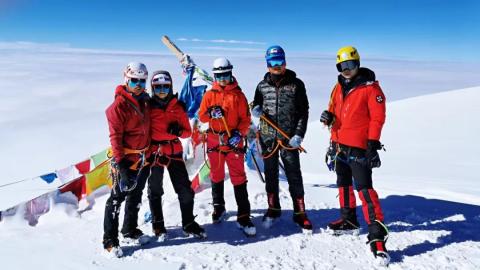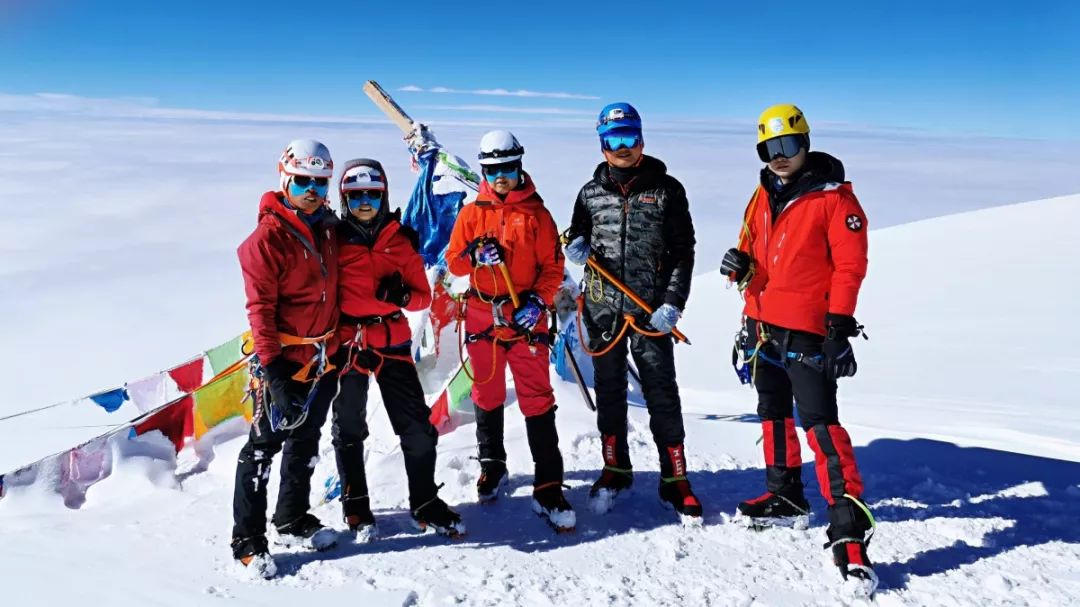
Snow-capped mountains have always been synonymous with beautiful scenery for us mortals.
Many people may have a snow-capped mountain in their wish list. It could be Mount Kailash, the highest peak in the Alps, Mont Blanc, or Kilimanjaro in Hemingway's novel.
The popular National Day movie "The Climber" tells the story of the Chinese mountaineering team's difficult journey to climb Mount Everest. As my country's first mountaineering-themed film, it vividly displays the cruelty and magnificence of the towering snow-capped mountains. Climbing Mount Everest not only involves risking your life, but it is also a big challenge to your wallet (the starting price for commercial climbing is about 500,000 yuan). Therefore, for ordinary office workers, Mount Everest is more suitable for looking up.
In addition to the much-anticipated top of the world, there are many majestic and safe snow-capped mountains in China that are worth exploring. In August this year, I went to Golmud, Qinghai, and successfully climbed to the top of Mount Yuzhu at an altitude of 6,178 meters. I successfully checked into my first snow mountain and fulfilled my long-standing outdoor dream.

The first snow mountain in your life, you don’t need to challenge your limits, and you don’t just leave. I would like to share my experience and lessons learned from climbing snow-capped mountains (including early accumulation, equipment selection, physical training, target selection, altitude adaptation, etc.) for the reference of outdoor enthusiasts here.

Early accumulation
Before starting your first snow mountain, you need to have a comprehensive understanding of outdoor and mountain climbing, find a compatible partner, and make enough time for planning.
1. Knowledge reserve——Read various information about high-altitude snow mountain climbing and understand some basic concepts. for example:
Hyperreflexia: The body’s inadaptation to low air pressure
Hypothermia: The body's ability to produce heat is reduced, which can lead to death in severe cases
Dark crevasse: A gap in a glacier covered with snow that is difficult to detect from above.
…
Here we mainly recommend the classic outdoor guide book "Mountaining Bible", the WeChat public account "Above the Snow Line" and the 8264 Outdoor Information Network. All the outdoor knowledge you need can be found here.
2. Hiking and camping experience - It is recommended to have at least half a year of mountain activity experience and basic camping skills and equipment before climbing the snow line.
Hiking and camping again and again are good opportunities to communicate and learn with others. If you have zero basic knowledge, then make an appointment with friends, participate in weekend camping and short-distance hiking, and slowly accumulate experience and purchase equipment.
3. Choose a good partner - When trekking on mountains far away from civilization, a partner is essential. In the process of climbing snowy mountains, a good partner can lend a helping hand when you encounter difficulties. When I reached the summit of Yuzhu Peak, my partner noticed that I was exhausted and took the initiative to help me carry my backpack. I will always remember this kindness in my heart.
4. Make enough time - No more than weekend camping, it takes at least a week or more before and after climbing a snow mountain. You need to make enough time for this, and the longer the better, so that you have more Time to adapt to the plateau.
Including transportation, the climb to Mount Yuzhu took a total of 8 days. My partners also asked me to climb Muztagh Peak (7546 meters) together next year. When I learned that the trip would take at least 20 days, I had only 5 days of annual leave and could only reluctantly refuse.
5. Best climbing time - The environment of a snow-capped mountain changes with the seasons. Seasons with relatively warm temperatures and no wind are the best times for climbing a snow-capped mountain.
Mountain friends are most familiar with the big and second peaks of Siguniang Mountain, or the Haba Snow Mountain in Yunnan, as well as this time's Mount Yuzhu. The best climbing times are:
Siguniang Peak and Second Peak - can be climbed all year round, but autumn (October, November) is the best, followed by summer (July, August, September). There is a lot of snow in winter and spring, and there are strong winds in winter.
Haba Snow Mountain - can be climbed all year round, preferably from March to October. The wind is strong and cold in winter, and the climbing difficulty is relatively increased, so it is not suitable for the first climb.
Mount Yuzhu - the best time to climb is from May to October, when the winter and spring winds are strong and cold.
With the above foundation, you have achieved a 15% success rate, but the top of the snow-capped mountains is different from hiking on forest trails. You also need professional equipment to combat low temperatures, strong winds and strong ultraviolet rays.

In your pursuit of higher and farther mountain journeys, the first snow mountain is your milestone. You will stand at an altitude of about 6,000 meters and start a new height in life; you will step above the snow line and feel the low temperature and wind and snow at high altitudes; you will trek through steep snow slopes and experience the hardship and fun of every step.
But new heights in life require equipment support.

Professional equipment
Professional equipment means clothing, footwear, socks and technical equipment specially designed for snowline and alpine environments. It is precisely because of these modern equipment that the threshold for ordinary people to climb snow-capped mountains has been greatly lowered.
1. Down jackets and pants - When hiking, waterproof and breathable jackets and pants are the mainstay, while down jackets and pants may be just a backup thermal product. But in high-altitude snow-capped mountains, a set of thick down jackets will become your absolute mainstay against the cold.
Thick down pants and down jackets can ensure that you do not lose temperature, suffer from frostbite, or lose too much energy due to fighting the cold under normal circumstances.
2. Windproof and warm hat - At high altitudes, the temperature is low and the wind speed is fast. A hat with good windproof and warm performance is very important. If you only wear a woolen hat, the cold wind will ruthlessly take away your heat. More than half of the body heat is lost through the head. Therefore, wearing a hat in cold weather can promote blood circulation in the limbs and help keep the body warm.
Mountain enthusiasts can choose a hat made of windproof fleece material, or wear a jacket hood over an ordinary wool hat to achieve windproof effect.
3. Thickened wool socks - When climbing a snow-capped mountain, your feet will be trudging in the snow all the time, and heat will easily escape, causing your feet to become numb and even frostbite. Therefore, you’d better prepare a few pairs of thickened wool socks. Keeps feet dry and warm while wicking away moisture. If necessary, wear two pairs.
4. Warm gloves - The surface area of hands is large and far away from the core heat-producing area of the body, so they are most susceptible to frostbite. Thick gloves are a must-have for long periods of exposure to cold weather. A pair of thin fleece gloves and a pair of thick windproof gloves are a good combination.
5. Alpine sunglasses or snow goggles - For high-altitude climbing, the intensity of sunlight will increase by 4% for every 300 meters of altitude increase. Strong ultraviolet rays will bring the risk of snow blindness. If you don’t have sunglasses or snow goggles, it is likely to cause you My glasses kept crying and were swollen and painful.
The reflectivity of the snow surface is close to 100% of sunlight. The lower part of ordinary sunglasses transmits light and cannot provide effective protection. Use climbing sunglasses or snow goggles to effectively protect your eyes.
6. High-power sunscreen——The sunlight becomes stronger as it climbs. Sunglasses and hats cannot cover your entire face, and the exposed skin will be sunburned, turning a white face into a painted one. For this, you need to apply sunscreen. Traveling along the snow line usually takes a whole day. It is recommended to use products with SPF higher than 30.
When it comes to sun protection, I learned the hard way. When summiting and descending Mount Yuzhu, I forgot to apply sunscreen on my face, which resulted in severe sunburn on the skin below the eyes, causing peeling and pus. After applying the medicine for a month, the wound completely recovered, and my skin turned dark. I regretted it endlessly.
7. Alpine sleeping bag - The atmosphere at high altitude is thin and the thermal insulation performance of the atmosphere is weak. The nighttime cooling in the snow-capped mountains is very huge. If the sleeping bag is not thick enough, it may be difficult to sleep and affect climbing, or frostbite and hypothermia may be life-threatening. Therefore, it is recommended to bring a sleeping bag with a comfortable temperature scale of at least minus 15 degrees.
8. Alpine Tent - Because the high-altitude snow-capped mountains are covered with snow and have no vegetation, the wind speed sometimes becomes extremely high. Ordinary camping tents may fall apart at any time under strong winds at high altitudes. Therefore, it is necessary to use an alpine tent with higher wind resistance. When we were at the base camp of Mount Yuzhu, it rained and snowed at night, and we witnessed the traveler's tent being blown down by the strong wind, and he had to spend the night in a car.

In addition to the professional equipment listed above, climbing snow mountains also requires dozens of equipment such as mountaineering bags, moisture-proof pads, helmets, headlamps, ice axes, trekking poles, snow boots, alpine boots, crampons, safety belts, ascenders, main locks, etc. , limited by space, we will not introduce them one by one here.
Purchasing equipment is a time-consuming and costly project, and a set of sophisticated snow mountain equipment will cost at least tens of thousands. If you just want to try something new, you might as well rent some equipment from travel friends or outdoor companies, which can save a lot of money.

You have purchased all professional equipment, which is one step closer to success, reaching 30%. But blacksmithing still requires its own hard work. Once the external hardware keeps up, its own hardware must also keep up.
How to train, how to start
We are not done yet
